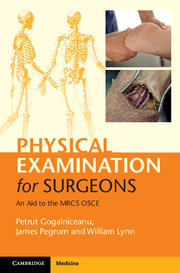Book contents
- Frontmatter
- Dedication
- Contents
- List of contributors
- Introduction
- Acknowledgments
- List of abbreviations
- Section 1 Principles of surgery
- Section 2 General surgery
- Section 3 Breast surgery
- Section 4 Pelvis and perineum
- Section 5 Orthopaedic surgery
- 14 Generic joint examination
- 15 Examination of gait
- 16 Examination of the cervical and thoracic spine
- 17 Cervical spine injury: assessment in trauma
- 18 Examination of the shoulder
- 19 Examination of the elbow
- 20 Examination of the lumbar spine and sacroiliac joint
- 21 Examination of the hip
- 22 Examination of the knee
- 23 Examination of the ankle
- Section 6 Vascular surgery
- Section 7 Heart and thorax
- Section 8 Head and neck surgery
- Section 9 Neurosurgery
- Section 10 Plastic surgery
- Section 11 Surgical radiology
- Section 12 Airway, trauma and critical care
- Index
16 - Examination of the cervical and thoracic spine
from Section 5 - Orthopaedic surgery
Published online by Cambridge University Press: 05 July 2015
- Frontmatter
- Dedication
- Contents
- List of contributors
- Introduction
- Acknowledgments
- List of abbreviations
- Section 1 Principles of surgery
- Section 2 General surgery
- Section 3 Breast surgery
- Section 4 Pelvis and perineum
- Section 5 Orthopaedic surgery
- 14 Generic joint examination
- 15 Examination of gait
- 16 Examination of the cervical and thoracic spine
- 17 Cervical spine injury: assessment in trauma
- 18 Examination of the shoulder
- 19 Examination of the elbow
- 20 Examination of the lumbar spine and sacroiliac joint
- 21 Examination of the hip
- 22 Examination of the knee
- 23 Examination of the ankle
- Section 6 Vascular surgery
- Section 7 Heart and thorax
- Section 8 Head and neck surgery
- Section 9 Neurosurgery
- Section 10 Plastic surgery
- Section 11 Surgical radiology
- Section 12 Airway, trauma and critical care
- Index
Summary
Checklist
WIPER
• Patient standing in shorts or underwear. Access is required to the neck and thoracic cage.
Physiological parameters
Gait and balance
• Smoothness and symmetry
• Sagittal balance
Look
• Skin: erythema, scars (posterior and anterior), alignment of skin creases
• Soft tissues: swelling; wasting of paraspinal muscles, intervertebral spaces
• Bone: scoliosis, kyphosis, lordosis, rib cage asymmetry, shoulder girdle
Feel
• Skin: temperature, tenderness, sensation
• Soft tissues: paraspinal muscle bulk and spasm
• Bone: spinous processes, facet joints, sacroiliac joints, coccyx
Move
• Active:
• flexion/extension of spine
• side flexion of spine
• rotation of spine
Special tests (* = essential tests)
• Spurling's nerve root compression test*
• Axial compression test*
• Disc test: Valsalva manoeuvre*
• Neurological examination*
• Thoracic outlet syndrome (see Chapter 26)
• Waddell's behavioural signs
To complete the examination…
• Examine the shoulder, lumbar spine and sacroiliac joint.
• Check full neurovascular status of the lower limb.
• Order appropriate radiographs and further imaging.
Examination notes
What do you look for during gait and initial observations?
Look at the sagittal and coronal planes of the patient. In the sagittal plane a vertical line should be drawn through the ear, shoulder, hip, knee and ankle. This quick screening test helps identify any spinal deformity, for example found in ankylosing spondylitis.
What signs should be identified in examining the skin?
The skin needs to be assessed for signs of systemic disease:
• Café-au-lait spots found in neurofibromatosis.
• Psoriasis, cutaneous vasculitis or nodules found in rheumatoid arthritis.
• Evidence of steroid use with striae, telangiectasia, skin thinning and bruising.
• Scars: evidence of previous cervical spine surgery via a posterior or an anterior approach (where a scar is found in the skin crease medial to the sternocleidomastoid).
How should the soft tissues be inspected?
The symmetry of the surrounding soft tissues and muscles are assessed:
• Anteriorly: the scalene, sternocleidomastoid and pectoralis muscles.
• Posteriorly: the paraspinal muscles (levator scapulae, trapezius, rhomboid and trapezius muscles) are palpated.
- Type
- Chapter
- Information
- Physical Examination for SurgeonsAn Aid to the MRCS OSCE, pp. 130 - 137Publisher: Cambridge University PressPrint publication year: 2015



